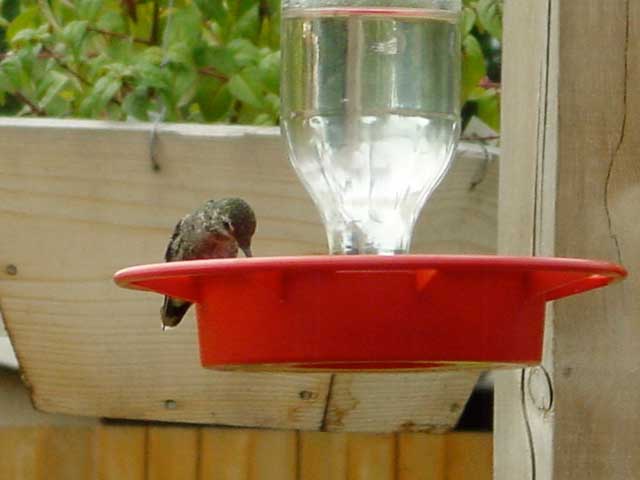Hot Tub Hummingbirds
 Uncle Andrew
Uncle Andrew
Okay, so they’re not really in the hot tub, but you get the point. Hey, at least I didn’t entitle the post “Hot Tub Hummer”. Ooo, can’t wait to see the searches I catch in my referrer log now…. 😆
Based on a suggestion from Shawn, we recently moved our two hummingbird feeders in from their habitual spots on the outer edge of the grape arbor we built over our hot tub. They are now hanging under the roof of the arbor, suspended from some of the hardier grape vines. This helps to protect them from the near-perpetual drizzle of Winter while simultaneously obviating the need for some sort of rain-umbrella arrangement, which tends to get semi-airborne during the occasional high wind.
Contrary to my fears, the greater proximity to the hot tub (and the attendant humans poaching themselves therein) has not fazed the hummers in the least. In fact, they seem to have easily incorporated us tubbers into their internal geographic lexicon of acceptable terrain elements without a hitch. I believe that this is because they simply cannot conceive of anything as glacially slow as a human as representing an actual threat. Like an inanimate pile of boulders, so long as they keep their eye out for the occasional avalanche, we present no perceptible hazard. It’s not true, of course, but the hummingbirds can be excused for not recognizing the dangers represented by global climate change, gray water runoff and industrial pollutants. After all, they gots a brain the size of a poppyseed.
Se we’ve been seeing a lot of the little buggers over the winter. The primary hummingbird for this area is the Anna’s, a medium-sized hummer in a nice tasteful shade of jade green.

Anna’s are notoriously territorial, and will often spend more time chasing other Anna’s (“Anna’ss”? Plural for more than one Anna’s? Whatever) away from the feeders than they do actually drinking from them, which strikes me as counterproductive, but whatever, it’s not my problem. It’s tremendous fun to watch them zipping in and out of the arbor, landing, drinking, flitting back and forth between the two feeders and driving away competitors in a dizzying three-dimensional ballet of aerial thrust, parry and dodge. Good fun for all involved.
Margaret and I were watching the Anna’s this morning when it struck me to wonder just how the species managed to survive the Washington winters before the arrival of humans and their bottles of sugar water. Many species of hummingbirds migrate during the cold months, but here in the Puget Sound area the Anna’s seem to hang out year ’round. While we’re certainly no frozen tundra, it can get pretty cold from November through March (nights are in the twenties right now), and there’s certainly no abundance of flowers from which to draw their sustenance.
As it turns out, these particular hummers don’t usually migrate per se; that is, they don’t travel long distances to a separate habitat when the temperatures plunge. Rather, the Anna’s Hummingbird travels only as far as is needed to find comfortable climate and a consistent food supply. In fact, according to BirdWeb, the Anna’s are a fairly recent emigrant to Washington, having followed the wave of newly-erected hummingbird feeders up from their native stomping (can something that weighs in at maybe an ounce soaking wet even manage a “stomp”?) grounds in California, all the way up into British Columbia. Human beings have influenced the dispersal of this species, not through habitat destruction as is our wont, but by providing a surfeit of readily accessible food.
As a Liberal White Guy living in an industrialized nation, I should probably feel guilty about this massive disruption of the normal life cycle of the Anna’s Hummingbird, but I can’t bring myself to do so. I enjoy their presence at our feeders too much. And the hummers seem all for it. Maybe I can assuage my conscience with a check to the World Wildlife Fund or something. And an extra bottle of sugar water. 😉


